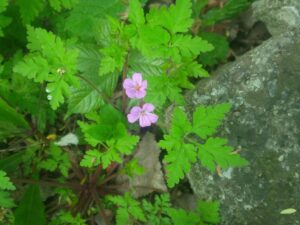 Last week I was in the Hudson Highlands section of New York State, hot on the trail of an interesting ruin. The ruin in question was once a stately house, built in the early twentieth century, and destroyed by fire fifty years later. All that remains of the house are portions of the stone foundation and entryway, plus a massive central chimney, but you can still see the outlines of the garden. Vinca minor and pachysandra, clearly escaped from the original landscape, had spread far and wide on the property.
Last week I was in the Hudson Highlands section of New York State, hot on the trail of an interesting ruin. The ruin in question was once a stately house, built in the early twentieth century, and destroyed by fire fifty years later. All that remains of the house are portions of the stone foundation and entryway, plus a massive central chimney, but you can still see the outlines of the garden. Vinca minor and pachysandra, clearly escaped from the original landscape, had spread far and wide on the property.
All of that was fascinating, but what really piqued my interest were diminutive plants that I saw growing out of crevices in the rocky outcroppings that flank the sloping estate driveway. Despite the fact that it was early November and hard frosts had already hit the area, little herb Robert plants were flourishing and even blooming from their precarious rocky perches. The sight of them was surprising and inspiring.
Herb Robert is more properly known as Geranium robertianum. As the name suggests, it is a hardy geranium, and part of the large Geraniaceae family. It is closely related to the scores of other hardy, perennial geraniums currently in the commercial market, including the celebrated ‘Rozanne’. It is more distantly related to the common pelargoniums or window box geraniums that many of us are now consigning to the compost heap during fall clean-up.
Herb Robert hugs the ground with beautiful, deeply dissected, ferny foliage and five-petaled pink flowers that are about one quarter inch wide. The stems are an eye-catching shade of red and covered with tiny hairs. I have never rubbed herb Robert foliage, but many sources report that the leaves exude a “mousey” scent. I have never actually smelled a mouse, but I defer to the consensus of those who are familiar with the odors of both plants and the rodents.
This characteristic scent is also reputed to repel mosquitoes, though if you are looking for a geranium that does that job, it is probably better for your social life to use the lemon-scented Pelargonium citrosum, better known as “citronella”.
Herb Robert is native to Europe and western Asia, and some sources also claim that it is indigenous to the eastern half of North America. It is much more likely that the species emigrated with the first generations of Europeans and, like other ubiquitous “wild” plants, established itself widely and successfully here. Having crossed the Continental Divide, it is considered an invasive weed in parts of the West.
The delicacy of the flowers and foliage belie the plant’s toughness and adaptability. I have seen it growing and flowering in sidewalk cracks, along railroad tracks and on shale beaches. It can also relax into the relatively hospitable climate of the average garden, provided the gardener does not consider it an unwelcome visitor.
I wouldn’t mind herb Robert in my garden, because it is lovely and requires no care at all. Unwanted seedlings are very easy to pull out, unlike those of some other voracious weeds.
In my garden, herb Robert would face stiff competition from its relative, erodium, or heron’s bill, another hardy geranium that goes wherever it wants. Both feature the same distinctive seedpods, which are rounded at the base, but end in long projecting “bills”, giving rise to avian nicknames like “cranesbill”, “heron’s bill” and “stork’s bill”. When the seedpods ripen and split, the plants can project the seeds over a great distance, contributing to their rapid spread.
The name “herb Robert” has been the subject of much scholarly discussion. In some European locales, it is called “St. Robert’s herb”, alluding to a seventh century French monk who used the plant medicinally. “Robert’ may also be a corruption of the Latin word for “red”, a reference to the red stems. Whatever the derivation, herb Robert has, over the centuries picked up scores of local nicknames in a variety of European languages.
Mousey smell notwithstanding, decoctions of herb Robert stems and leaves have been used medicinally for centuries. At various times and in various places, herbalists have recommended it for everything from strengthening the heart, to relieving chest pains and rheumatism, curing hoarseness, breaking up kidney stones and acting as a diuretic. Some herbalists may use it still. Author Stephen Orr lists herb Robert as one of a number of “herbs from older traditions” in his wonderful and comprehensive book, The New American Herbal, published in 2014.
Clearly herb Robert carries a load of historical baggage. Yet, despite that load, it has the strength to burst forth and flower from a narrow crack on a cold November day when most of the surrounding plants had withered in the cold winds. Not many of us—human or botanical—have that much tenacity.
